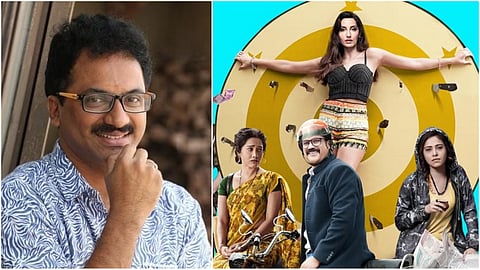

Pushpaka Vimana, the 1987 classic by Singeetam Srinivasa Rao starring Kamal Haasan, holds an iconic status in Indian cinema for being a rare mainstream attempt at a dialogue-less film. It is so iconic that it took 38 years for another mainstream filmmaker to take a swing at the genre. That’s what makes Ufff Ye Siyapaa, the upcoming film directed by G Ashok, stand out. Ashok recalls feeling the sadness as a young boy when he first watched Pushpaka on VHS and realised what he missed in theatres. Cut to 20 years later, in 2008, when Ashok had just started out as a filmmaker, he developed a story on these lines for a small-budget film. “But the story would stop after 40 minutes. We couldn’t find a way to develop it further.” The director picked this story again a few years later after the success of Nani-starrer Pilla Zamindar. He reflects, “I remember narrating it to Nani too, who showed a lot of interest. Later, another star hero came on board. While the project didn’t materialise, their excitement gave me good confidence.”
All these years later, in the times of instant communication when people have found ways to reduce usage of words, Ashok points out how that indirectly led to the genesis of Ufff Ye Siyaapa. “On our mobile phones, devices meant for talking, we invented WhatsApp and emojis, finding symbols to make others understand without using words. That’s when the thought struck me again, ‘Why can’t we make a film with no dialogues?’ I narrated the story to Luv Ranjan, and he was instantly on board,” he notes.
The real vote of confidence came from none other than AR Rahman, who is composing music for the film. Ashok recalls treating the story session with Rahman as a ‘litmus test’ for his script. “If he rejected the story, it means the story is no good. During our two-hour session, I didn’t just narrate the script; I enacted every action visually. When Rahman was convinced, I knew I could tell this story to the audience too with similar impact,” Ashok notes.
The Pilla Zamindar filmmaker also acknowledges Rahman’s contribution to the final shooting draft. “After our narration, Rahman called me to Chennai and presented me with 8 musical stems. He had actually worked out musical cues based on my narration style. We then decided to reverse engineer those musical themes into the script. If you see the film, Nushrratt’s head nods or Sohum’s walking steps are in sync with the music. We did our homework.”
Ashok explains the difference between his film and Pushpaka Vimana, though. He elaborates, “We didn’t make it with the idea of no characters talking on screen. Instead, it’s a story where no character gets an opportunity to talk, and there are 22 of them. Pushpaka had occasional muting. Here, we have a 23rd character, a mute guy who is the only one desperately trying to convey something, but everyone else is immune to his attempts. It’s an out-and-out comedy that comes out of other people’s frustrations.” There are a few other elements that distinguish the two movies, Ashok notes, “There are no signboards here, no background announcements, and no subtitles.” The filmmaker also recalls finding newer learnings as a writer. “While penning the script for Siyapaa, I learned there is a lot of excessive writing we do often, writing useless pages for many things that could be conveyed without dialogue.”
There is a certain lack of inhibition that’s very integral to the performances of Ufff Ye Siyapaa, Ashok tells me, adding, “I needed actors who could behave like there are no cameras around.” He also recalls being conscious about cthe casting for this film. “Sohum (Shah) is crazy about movies. He is not here for money since he comes from wealth already. He was willing to put on 18 kgs for this role; I needed such dedication from my lead actor,” says Ashok, who recalls being impressed by Nushrratt Bharuccha’s performance in the 2018 blockbuster Sonu Ke Titu Ki Sweety. “She would convey anger or wrath with a simple glance. That’s when I knew she had the capacity to express with her eyes.” He adds, “I compulsorily chose trained artists for this film, including a Delhi-based theatre actor, Sadanand Patil.”
And despite the theater background and training, Ashok says the trick was to balance theatrical and cinematic acting, adding, “I hired all these actors only to tell them, ‘Don’t go for a wholly theatre-style acting; this is not a play’ (laughs). The trick was to get all 22 characters on the same wavelength. This lining up of metre was difficult, but they all succeeded.”
While contemporary filmmakers are struggling with diminishing theatrical footfalls, Ashok sees the more discerning audience as a positive, especially for a film like Ufff Ye Siyapaa. “They get even the most complex stories easily now. They are watching world cinema. As soon as they watch a trailer, they have a judgment factor of whether they want to watch the film or not.” Infact, Ashok finds his target audience in this discerning audience. “These people who will buy a great phone on EMI if it has great features are my target audience, who want novelty in movies. Especially youngsters from 14 to 35, who probably didn’t grow up watching Pushpaka,” he notes.
Ashok says his experience making Ufff Ye Siyapaa has given him a new boost for his upcoming projects. He has already signed two Telugu films. “A big project is loading. And now I am used to shooting on a swift schedule. Maybe I can deliver my next film by the end of this year,” Ashok signs off.